Eh, sledgehammer, let's go away: like in “Salute-7” they made unscientific fantasy instead of historical cinema
In a sharply critical review of the spring trailer for the Salyut-7 film, I quite sincerely wrote that I would like to be mistaken in my expectations and that the cinema should turn out good in the end. Alas, I was able to watch the film only because in the first half of it I switched my perception from the mode “historical cinema” to “unscientific fantasy”. Tastes are a personal matter, someone may like the picture. In any case, a variety of errors and inaccuracies are an excellent reason to talk about what actually happened in history and how the technique shown on the screen worked. And at the end of the day, I want to tell you what, in my opinion, would be the perfect film on these events.
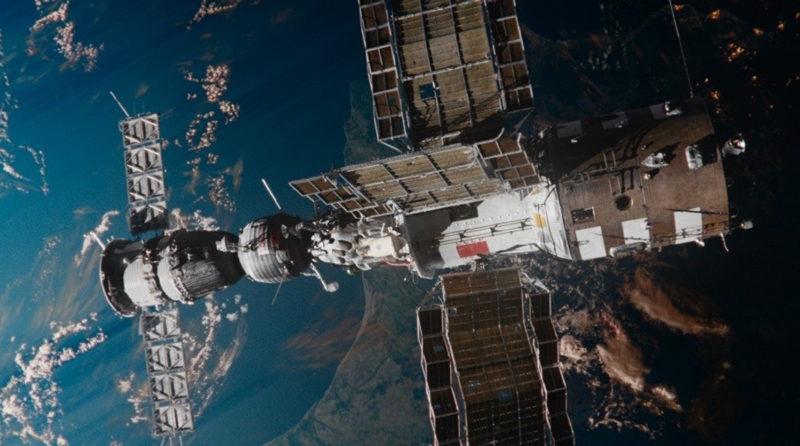
Frame from the film
Features of the picture can be felt from the first minutes. The cosmonauts Dzhanibekov and Savitskaya (in the film, the names are changed) are engaged in welding during extra-maritime activities, naturally having fun with jokes about sex in space (hello, "Gravity", which also began with jokes in outer space). Svetlana pierces the spacesuit, and the first woman, who went into outer space, immediately finds herself in a “virgin in trouble” situation. However, they are not in a hurry to save her, because the partner sees a nonworldly light with angels. After returning to Earth, the Janibekov film version is recognized as unsuitable for flying because of this.
In reality, there was a very successful spacewalk of Janibekov and Savitskaya on July 25, 1984. It checked the universal hand tool (URI), which could cut, weld, solder and spray coating.
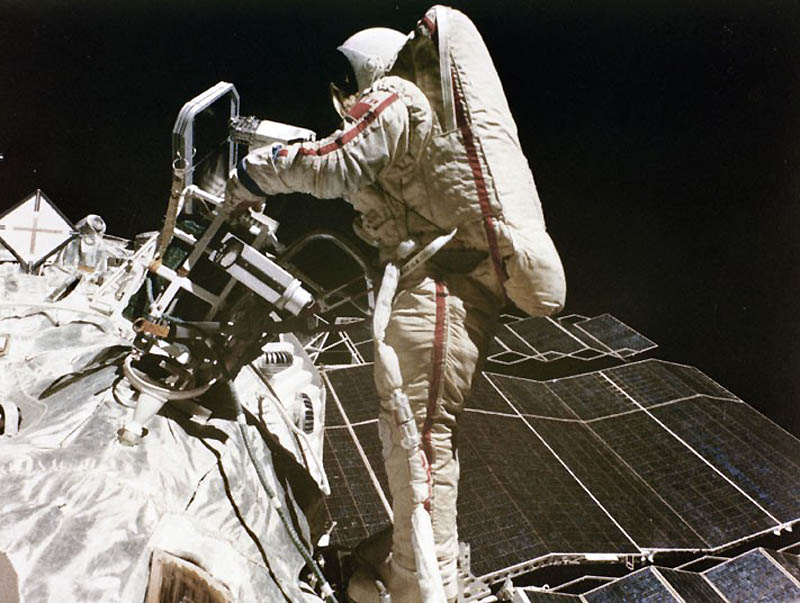
The same spacewalk, Svetlana works, photo by Vladimir Dzhanibekov
In the history of astronautics, two cases of damage to a spacesuit's glove are known, but both of them, ironically, happened to American astronauts. In the 1991 STS-37 mission, a restrictive palm rest pierced the suit's glove, but this was discovered only after returning - the air leak was too weak to be noticed. In 2007, at the mission STS-118, when a spacewalk was discovered, damage to the glove was noticed, the exit was completed ahead of time, but there was no danger — only two of the five layers suffered. There are also many layers on the Soviet / Russian Orlan spacesuits, and the fingertips are covered with plastic fingertips, so piercing them is not so easy. Also, absolute tightness is unattainable, and any spacesuit has an atmosphere loss rate. And in special suits for extra-shipping activities there are additional cylinders in order to cope with a small leak.
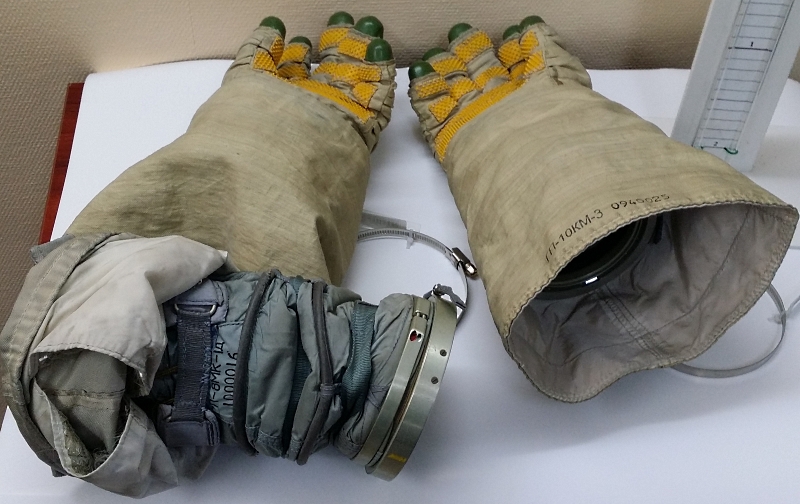
Gloves space suit "Orlan", the store of the Museum of Cosmonautics, own photo

Frame from the film
In the film, the solar panels of the station damage meteorites, after which the shutdown of a unit that de-energizes the station is shown. Hello again, Gravity.
In reality, the station was de-energized for other reasons. The incident is described in great detail and clearly in the fourth book of the series “Missiles and People” B.. Chertok. On February 11, 1985, in the control system, the overcurrent protection was triggered - a traffic jam was struck at one of the transmitters of the radio communication system. Automatics switched to backup. The main transmitter has already developed a resource, so its failure was not surprising. According to the instructions, it was necessary to wait for the arrival of specialists in the control system and communication system, but the next shift in the MCC tried to turn on the main transmitter - and what if the operation of the automation is random? Alas, this was an erroneous decision - the command to turn on the main transmitter caused a short circuit that caused the receivers and decoders in the same block as the emergency transmitter. The station has lost the ability to receive commands from Earth. A short-circuit current of 100-120 amperes discharged the station's batteries and disabled the program-temporary device, which should regularly give a command to recharge the batteries from solar panels. Without the battery current, the thermal control system stopped working, and the station began to freeze - according to calculations, the temperature inside it should have dropped to -20 ° C. The deafened station could not be reanimated remotely, people had to fly.
In the film and some documentaries, it is strongly emphasized that the uncontrollable fall of Salyut could be a global catastrophe. Ironically, in 1991, the station made an uncontrollable descent from orbit, and unburned debris fell in Argentina. Near the amateur observatory Oro Verde lies as an exhibit one of the largest pieces.
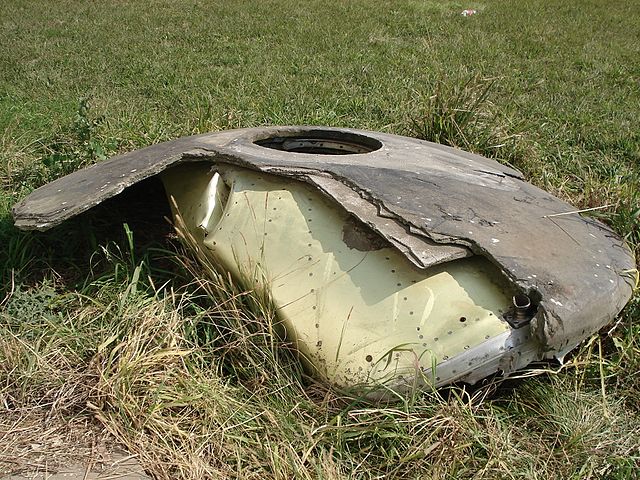
Photo Carloszelayeta / Wikipedia
In addition, the findings of pipes, plates, rings and other small fragments are mentioned. There were no casualties. In the case of the fall of the station in a densely populated area, there could be isolated casualties, but the actual damage would be much less than the media hype.

The geometric error of the filmmakers, in fact, the size of the cargo compartment is 4.6 mx 16 m, thanks for the attentiveness of the Beholder
Another issue that rises in the cinema and in documentary programs - allegedly the Americans were going to kidnap the Salyut-7 station on the Space Shuttle. Very short and the points:
In the recently released film “Salute-7. The story of one feat "this version is repeated, and the journalists even came out on Norman Taggart, a member of the crew of STS-51B, who says that the rapprochement with the" Salute "was accidental. It is also claimed that a photograph of the emergency station was allegedly taken from the shuttle. Here she is:

The photograph shows the Salyut-7 station, which is indeed similar to an emergency one - additional panels are not deployed on one of the solar panels (narrow ones on the side of the main wide one), and the angle of rotation of the panels looks abnormal. Savinykh himself in the program says that he did not see this photo in the Soviet archives, which means that it was made by the Americans. In Wikipedia, this photo was attributed as “the broken station Salyut-7, the photo was taken by the crew of the Soyuz T-13”. But this is not true - the link to the source is not available, but this photo is not signed in the web archive . I could not find this photo in the online archives of NASA, it does not have a unique number that is often found in their archives. As the source of the photo, the agency Sovfoto / Eastfoto is indicated, so most likely the explanation on Occam's razor is true - this is a Soviet photo, and the Savinykh was mistaken.
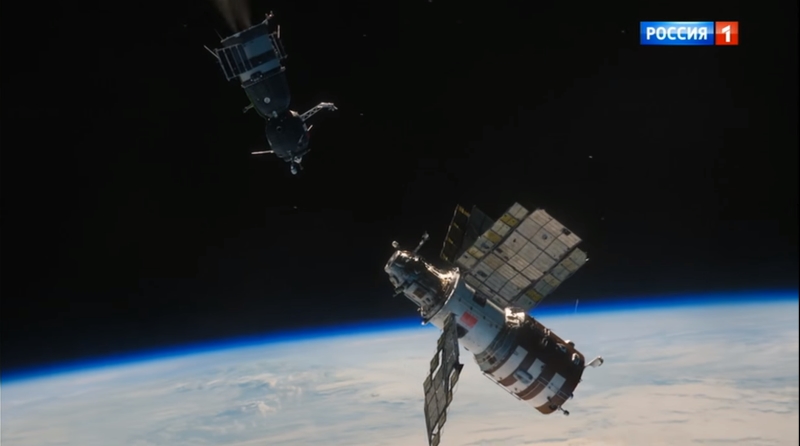
The docking in the form in which it is shown in the film is not historical or realistic. First of all, in reality, the station practically did not rotate. And the pitch rotation would make the docking altogether impossible. The Soviet / Russian “pin-cone” docking station works like this:

Source: Science and Life , 1988
If the station rotated strongly, then at stage B, the inertia of a station weighing more than 20 tons would start to act on the pin on one side, and on the other side a ship weighing 7 tons. Docking rod would break or vomit.
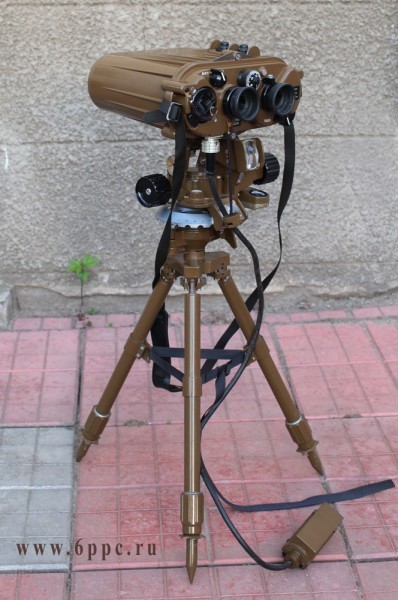
Laser range finder LPR-1, photo 6ppc.ru
But an interesting and truly dramatic stage of convergence was never shown. The fact is that ballistics could bring the ship closer up to a distance of several kilometers from the station. The standard VSK-1 manual docking system (Vizier special astronaut) could be used from a distance of several hundred meters. And there was no option for manual convergence between them. In an extremely short time, RSC Energia’s engineers and cosmonauts of the CPC were able to develop a rendezvous technique when the ship’s commander measured the range with a LPR-1 military laser rangefinder and controlled the ship from a backup set of control knobs, and the flight engineer sat with the calculator and calculated the necessary maneuvers. This is described in more detail in a separate article .

A layer of hoarfrost and a flood at the station is a frequent blow-up of a fly into an elephant in the cinema to make it more dramatic. In reality, the station had a bit of frost and very cold (knitted hats are a historical fact). In the negotiations, there really is a proposal from the MCC to spit and check whether the spittle will freeze. Frozen in three seconds. When the station was warmed up, it became damp, and the astronauts put all the available fabric on the rags. It was especially scary to wipe the cables before connecting. But, of course, the actual amount of water was less drawn. Against the background of subsequent errors, I do not even want to find fault with this.
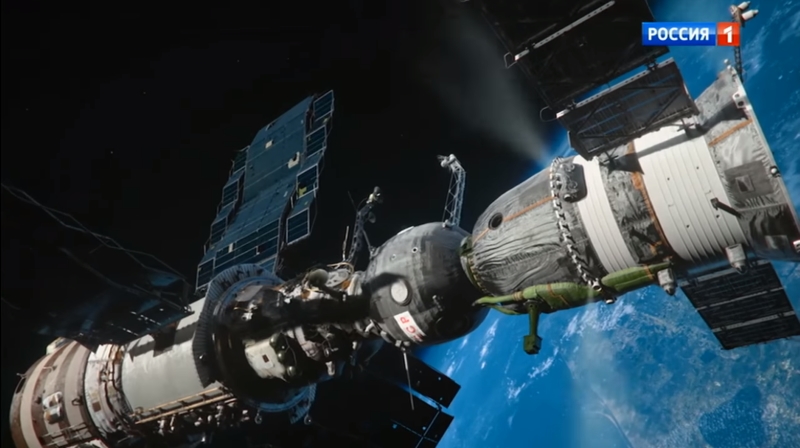
The story of a solar sensor with a closed melted blend is sad because it is meaningless. In reality, the station was first turned by solar panels on the Sun by the engines of the orientation of the ship (and this is even shown once in the film!), And the cables from the panels were connected directly to the batteries, bypassing any electronics. So all the heroism with a sledgehammer was simply not needed. A separate sad smile is caused by the fact that after the hood was finally successfully knocked down, everything magically became good, despite the fact that the Sun was along the longitudinal axis of the station and, in theory, outside the sensor's visibility.
The history with a fire and high-speed spacewalks simply does not hold water. The plot of the fire is clearly taken from the history at the Mir station and is greatly exaggerated for drama. And it will not be possible to immediately dress in a spacesuit - there is lowered pressure, and it is necessary to breathe pure oxygen in advance for a long time so that the nitrogen in the vessels does not boil.
At the same time, there were real dangers at the station. For example, because of inadequate ventilation, the astronaut found himself in a bubble with a high content of carbon dioxide, which he exhaled. There was a real risk of loss of consciousness and asphyxiation. The second cosmonaut had to supervise the station worker, and if possible, they dragged the ventilation hoses with them. It is a pity that this was not shown. Household heroism of life and work in the refrigerator without hot food and drink on the screen is missing.
The reader can say: “Well, from the point of view of historical truth, there is a lot of fiction here. But maybe the film has an artistic merit that outweighs? ”Alas, it seems to me, no.

The only thing I'm really happy about is computer graphics. We have learned to shoot a very beautiful space, and this is wonderful.
The astronaut's work, in my opinion, is shown in a distorted form. Astronautics is teamwork, and instead of coordinated actions we are presented with a lone hero who breaks the rules and spits on instructions. Docking drills are not shown at all, instead it seems that no one can accomplish a task that a superhero solves in a magical way.
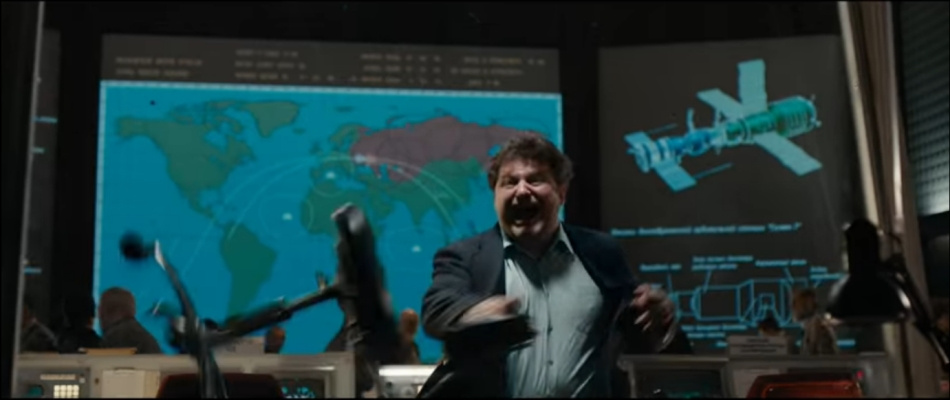
The work of the MCC is not visible at all. Instead of his job duties, the flight manager is engaged in inappropriate reflection, whining, comes to the brink of a fight and is thrown by the furniture. Only in the finale of the blend on the model they pounded with a sledgehammer to show that even on Earth, without a spacesuit, no one can do what the astronauts manage. It is doubly insulting that cosmonaut Valery Ryumin, who at the time held this position, is quite recognizable in the flight director.
Until now, our movie can not get rid of the punch "bloody gebni", and it is very sad. And there are stupid and evil generals who want to blow up the station along with the astronauts so that it does not go to the Americans, not realizing that such an action from the point of view of public relations is many times worse than losing the station or receiving help from a geopolitical opponent.
Relationships with relatives are also shown unsuccessfully. Yes, on the one hand, the wives are worried about the astronauts performing the really dangerous work. But for many years of marriage, they could understand why the husband loves his work. Yes, of course, it is difficult to show both this fear and understanding at the same time, but it is a pity that it did not work here.
Mostly the filmmakers made simple factual mistakes that could have been avoided with more thorough work with sources. The geometrical error with the size of the shuttle is shown above, besides in the film the shuttle flies in a non-floating configuration - a real orbiter immediately after going into orbit has to open the cargo compartment doors, because there is a thermoregulation system there. The Salyut-7 station is shown with all additional solar panels installed, although the third set was deployed by the Janibek and Savinykh after the station was reanimated.
In the final scene, the cockroach who got into one of the spacesuits, together with the astronauts saluting the Americans, is clearly not enough. This would have shifted the semantic spectrum of the film to trash, and after such a scene it would be completely inappropriate to find fault with historical and logical inconsistencies.
In the story of the film, the most pity is the real Dzhanibekov and Savinykh, who are both alive and have watched the film. Judging by the interview, neither Dzhanibekov , nor Savinykh liked the film, and this is not surprising - the real story is better and more beautiful than it was invented.
Despite a noticeable focus on the best examples of a movie about space, Salyut-7 turned out to be a mixture of unsuccessful ones: the Soviet film Return from Orbit, the American Marooned, and the worst moments of Time First. (The same pair of hero who breaks the rules and companion - Melancholy, drama "return only one" and "bloody geba"). I got the impression that our directors and scriptwriters should temporarily ban shooting of dramas - let them work out on family movies so that there is no temptation to try to pull out a film due to a sharp plot and mortal danger - this obviously does not work.
In the process of preparing the material, a fantasy occurred to me - to jot down something like a synopsis - what would be the ideal in my view film “Salute-7”.
SALUT-7, family cinema, production drama. Based on real events.

Frame from the film
Gloves and angels
Features of the picture can be felt from the first minutes. The cosmonauts Dzhanibekov and Savitskaya (in the film, the names are changed) are engaged in welding during extra-maritime activities, naturally having fun with jokes about sex in space (hello, "Gravity", which also began with jokes in outer space). Svetlana pierces the spacesuit, and the first woman, who went into outer space, immediately finds herself in a “virgin in trouble” situation. However, they are not in a hurry to save her, because the partner sees a nonworldly light with angels. After returning to Earth, the Janibekov film version is recognized as unsuitable for flying because of this.
In reality, there was a very successful spacewalk of Janibekov and Savitskaya on July 25, 1984. It checked the universal hand tool (URI), which could cut, weld, solder and spray coating.

The same spacewalk, Svetlana works, photo by Vladimir Dzhanibekov
In the history of astronautics, two cases of damage to a spacesuit's glove are known, but both of them, ironically, happened to American astronauts. In the 1991 STS-37 mission, a restrictive palm rest pierced the suit's glove, but this was discovered only after returning - the air leak was too weak to be noticed. In 2007, at the mission STS-118, when a spacewalk was discovered, damage to the glove was noticed, the exit was completed ahead of time, but there was no danger — only two of the five layers suffered. There are also many layers on the Soviet / Russian Orlan spacesuits, and the fingertips are covered with plastic fingertips, so piercing them is not so easy. Also, absolute tightness is unattainable, and any spacesuit has an atmosphere loss rate. And in special suits for extra-shipping activities there are additional cylinders in order to cope with a small leak.

Gloves space suit "Orlan", the store of the Museum of Cosmonautics, own photo
Crash

Frame from the film
In the film, the solar panels of the station damage meteorites, after which the shutdown of a unit that de-energizes the station is shown. Hello again, Gravity.
In reality, the station was de-energized for other reasons. The incident is described in great detail and clearly in the fourth book of the series “Missiles and People” B.. Chertok. On February 11, 1985, in the control system, the overcurrent protection was triggered - a traffic jam was struck at one of the transmitters of the radio communication system. Automatics switched to backup. The main transmitter has already developed a resource, so its failure was not surprising. According to the instructions, it was necessary to wait for the arrival of specialists in the control system and communication system, but the next shift in the MCC tried to turn on the main transmitter - and what if the operation of the automation is random? Alas, this was an erroneous decision - the command to turn on the main transmitter caused a short circuit that caused the receivers and decoders in the same block as the emergency transmitter. The station has lost the ability to receive commands from Earth. A short-circuit current of 100-120 amperes discharged the station's batteries and disabled the program-temporary device, which should regularly give a command to recharge the batteries from solar panels. Without the battery current, the thermal control system stopped working, and the station began to freeze - according to calculations, the temperature inside it should have dropped to -20 ° C. The deafened station could not be reanimated remotely, people had to fly.
Danger
In the film and some documentaries, it is strongly emphasized that the uncontrollable fall of Salyut could be a global catastrophe. Ironically, in 1991, the station made an uncontrollable descent from orbit, and unburned debris fell in Argentina. Near the amateur observatory Oro Verde lies as an exhibit one of the largest pieces.

Photo Carloszelayeta / Wikipedia
In addition, the findings of pipes, plates, rings and other small fragments are mentioned. There were no casualties. In the case of the fall of the station in a densely populated area, there could be isolated casualties, but the actual damage would be much less than the media hype.
Abduction and mystery photos

The geometric error of the filmmakers, in fact, the size of the cargo compartment is 4.6 mx 16 m, thanks for the attentiveness of the Beholder
Another issue that rises in the cinema and in documentary programs - allegedly the Americans were going to kidnap the Salyut-7 station on the Space Shuttle. Very short and the points:
- Salyut-7 is a civilian station, at which nothing particularly secret was supposed to be, cosmonauts of France and India flew on it under the Intercosmos program. The previous station "Salyut-6" was visited by many cosmonauts from other countries from Cuba to Vietnam. The military stations were "Diamonds", which for the purpose of conspiracy were designated as "Salyut" -2,3,5.
- Technically, it would be extremely difficult to kidnap the station - would have to cut off solar panels and antennas, as well as remove from the station and throw more than 6 tons of cargo - the shuttle could return 14.4 tons from orbit, and the Salyut-7 weighed 20 , and with new flights its mass only grew.
- The shuttle that actually flew in the spring of 1985 with the STS-51B mission was displayed on a different inclination (57 ° instead of 51.6 ° at the Salyut-7) and could only fly near the station with a large difference in speeds. Go to the orbit "Salyut-7" and it would not be enough to get close to him. Yes, and in the cargo compartment in this mission was a SpaceLab laboratory, which would have to be thrown out in order to take the Salut.
- Over the past decades, no documents have emerged that such a proposal was at least put forward, not to mention work plans, equipment and training for its implementation.
In the recently released film “Salute-7. The story of one feat "this version is repeated, and the journalists even came out on Norman Taggart, a member of the crew of STS-51B, who says that the rapprochement with the" Salute "was accidental. It is also claimed that a photograph of the emergency station was allegedly taken from the shuttle. Here she is:

The photograph shows the Salyut-7 station, which is indeed similar to an emergency one - additional panels are not deployed on one of the solar panels (narrow ones on the side of the main wide one), and the angle of rotation of the panels looks abnormal. Savinykh himself in the program says that he did not see this photo in the Soviet archives, which means that it was made by the Americans. In Wikipedia, this photo was attributed as “the broken station Salyut-7, the photo was taken by the crew of the Soyuz T-13”. But this is not true - the link to the source is not available, but this photo is not signed in the web archive . I could not find this photo in the online archives of NASA, it does not have a unique number that is often found in their archives. As the source of the photo, the agency Sovfoto / Eastfoto is indicated, so most likely the explanation on Occam's razor is true - this is a Soviet photo, and the Savinykh was mistaken.
Docking

The docking in the form in which it is shown in the film is not historical or realistic. First of all, in reality, the station practically did not rotate. And the pitch rotation would make the docking altogether impossible. The Soviet / Russian “pin-cone” docking station works like this:

Source: Science and Life , 1988
If the station rotated strongly, then at stage B, the inertia of a station weighing more than 20 tons would start to act on the pin on one side, and on the other side a ship weighing 7 tons. Docking rod would break or vomit.
Forgotten rendezvous

Laser range finder LPR-1, photo 6ppc.ru
But an interesting and truly dramatic stage of convergence was never shown. The fact is that ballistics could bring the ship closer up to a distance of several kilometers from the station. The standard VSK-1 manual docking system (Vizier special astronaut) could be used from a distance of several hundred meters. And there was no option for manual convergence between them. In an extremely short time, RSC Energia’s engineers and cosmonauts of the CPC were able to develop a rendezvous technique when the ship’s commander measured the range with a LPR-1 military laser rangefinder and controlled the ship from a backup set of control knobs, and the flight engineer sat with the calculator and calculated the necessary maneuvers. This is described in more detail in a separate article .
Re-dramatized

A layer of hoarfrost and a flood at the station is a frequent blow-up of a fly into an elephant in the cinema to make it more dramatic. In reality, the station had a bit of frost and very cold (knitted hats are a historical fact). In the negotiations, there really is a proposal from the MCC to spit and check whether the spittle will freeze. Frozen in three seconds. When the station was warmed up, it became damp, and the astronauts put all the available fabric on the rags. It was especially scary to wipe the cables before connecting. But, of course, the actual amount of water was less drawn. Against the background of subsequent errors, I do not even want to find fault with this.
Senseless heroism

The story of a solar sensor with a closed melted blend is sad because it is meaningless. In reality, the station was first turned by solar panels on the Sun by the engines of the orientation of the ship (and this is even shown once in the film!), And the cables from the panels were connected directly to the batteries, bypassing any electronics. So all the heroism with a sledgehammer was simply not needed. A separate sad smile is caused by the fact that after the hood was finally successfully knocked down, everything magically became good, despite the fact that the Sun was along the longitudinal axis of the station and, in theory, outside the sensor's visibility.
The history with a fire and high-speed spacewalks simply does not hold water. The plot of the fire is clearly taken from the history at the Mir station and is greatly exaggerated for drama. And it will not be possible to immediately dress in a spacesuit - there is lowered pressure, and it is necessary to breathe pure oxygen in advance for a long time so that the nitrogen in the vessels does not boil.
At the same time, there were real dangers at the station. For example, because of inadequate ventilation, the astronaut found himself in a bubble with a high content of carbon dioxide, which he exhaled. There was a real risk of loss of consciousness and asphyxiation. The second cosmonaut had to supervise the station worker, and if possible, they dragged the ventilation hoses with them. It is a pity that this was not shown. Household heroism of life and work in the refrigerator without hot food and drink on the screen is missing.
Artistic merit
The reader can say: “Well, from the point of view of historical truth, there is a lot of fiction here. But maybe the film has an artistic merit that outweighs? ”Alas, it seems to me, no.

The only thing I'm really happy about is computer graphics. We have learned to shoot a very beautiful space, and this is wonderful.
The astronaut's work, in my opinion, is shown in a distorted form. Astronautics is teamwork, and instead of coordinated actions we are presented with a lone hero who breaks the rules and spits on instructions. Docking drills are not shown at all, instead it seems that no one can accomplish a task that a superhero solves in a magical way.

The work of the MCC is not visible at all. Instead of his job duties, the flight manager is engaged in inappropriate reflection, whining, comes to the brink of a fight and is thrown by the furniture. Only in the finale of the blend on the model they pounded with a sledgehammer to show that even on Earth, without a spacesuit, no one can do what the astronauts manage. It is doubly insulting that cosmonaut Valery Ryumin, who at the time held this position, is quite recognizable in the flight director.
Until now, our movie can not get rid of the punch "bloody gebni", and it is very sad. And there are stupid and evil generals who want to blow up the station along with the astronauts so that it does not go to the Americans, not realizing that such an action from the point of view of public relations is many times worse than losing the station or receiving help from a geopolitical opponent.
Relationships with relatives are also shown unsuccessfully. Yes, on the one hand, the wives are worried about the astronauts performing the really dangerous work. But for many years of marriage, they could understand why the husband loves his work. Yes, of course, it is difficult to show both this fear and understanding at the same time, but it is a pity that it did not work here.
Mostly the filmmakers made simple factual mistakes that could have been avoided with more thorough work with sources. The geometrical error with the size of the shuttle is shown above, besides in the film the shuttle flies in a non-floating configuration - a real orbiter immediately after going into orbit has to open the cargo compartment doors, because there is a thermoregulation system there. The Salyut-7 station is shown with all additional solar panels installed, although the third set was deployed by the Janibek and Savinykh after the station was reanimated.
In the final scene, the cockroach who got into one of the spacesuits, together with the astronauts saluting the Americans, is clearly not enough. This would have shifted the semantic spectrum of the film to trash, and after such a scene it would be completely inappropriate to find fault with historical and logical inconsistencies.
Real heroes
In the story of the film, the most pity is the real Dzhanibekov and Savinykh, who are both alive and have watched the film. Judging by the interview, neither Dzhanibekov , nor Savinykh liked the film, and this is not surprising - the real story is better and more beautiful than it was invented.
Conclusion
Despite a noticeable focus on the best examples of a movie about space, Salyut-7 turned out to be a mixture of unsuccessful ones: the Soviet film Return from Orbit, the American Marooned, and the worst moments of Time First. (The same pair of hero who breaks the rules and companion - Melancholy, drama "return only one" and "bloody geba"). I got the impression that our directors and scriptwriters should temporarily ban shooting of dramas - let them work out on family movies so that there is no temptation to try to pull out a film due to a sharp plot and mortal danger - this obviously does not work.
Additional materials
- From the point of view of the designer and the engineer, the story of “Salyut-7” is perfectly told in the fourth book of B.Ye. Chertok "Rockets and People."
- Cosmonaut Savinykh wrote a book about this expedition, “Notes from a Dead Station”.
- The recently released documentary Salyut-7. The story of one feat ” is valuable documentary shots and records of real negotiations.
- My materials are more about technology, here is a good review telling about people.
Epilogue
In the process of preparing the material, a fantasy occurred to me - to jot down something like a synopsis - what would be the ideal in my view film “Salute-7”.
SALUT-7, family cinema, production drama. Based on real events.
Synopsis
Main actors: COMMANDER (KM), BORTENGENER (BI), LEADER OF FLIGHTS (RP), MCC ENGINEER.
SCENE 1. April 20, 1983. The ship "Soyuz T-8" is sent to the station "Salyut-7". When you reset the head fairing, one of the proximity system antennas is damaged and does not open. Earth produces an ersatz approach algorithm. The astronauts are trying to execute it, they estimate the speed incorrectly, they almost crash into the station, and at the last moment dive under it. It is not possible to dock. At the post-flight meeting in the MCC, system developers scold astronauts, representatives of the CPC - system developers. RP and ENGINEER conclude that a high-quality algorithm of manual approach is needed, but they cannot make time for its development.
SCENE 2. 1984. BI is a double for astronauts going into orbit. On the glass of the bus, he writes “there are 302 days left before the start”. His earthly life is shown - work, dissertation defense, daughter prepares for entrance exams, a summer cottage is built.
SCENE 3. February 11, 1985. Station "Salyut-7" flies automatically. Ensuring her work is a routine from which people relax. At the station the transmitter fails. Duty Shift MCC:
"- We will continue work on the backup transmitter? There is already a replacement at the station, astronauts will arrive, they will install a new unit.
- No, without a second transmitter, we will not have a reserve. And we do not know why he turned off. There are still fuses, turn on, check. "
They give the command to turn on the main transmitter, a short circuit is beautifully shown at the station, it fails. Unsuccessful attempts to reconnect. The drawings show that the unit burned down with both receivers and transmitters - only a person can correct the situation.
SCENE 4. Meeting in MCC. RP goes to the board (hello, Apollo 13) and draws:
"- Ballistics can bring us closer to a distance of five kilometers. But astronauts can manually move closer from a distance of 200 m. We need an approach algorithm from 5000 to 200 meters. Manually. Quickly."
SCENE 5. Smoked and piled room in the MCC. Ballistics and engineers are looking for convergence algorithms.
SCENE 6. Cosmonaut Training Center (CSC). Select the most suitable candidates. KM is best suited, but it has problems with medicine.
SCENE 7. Meeting in MCC. Ballistics and engineers report on the found algorithm. RP:
"- Your math is great, but I need a reliable and proven algorithm. And people who are trained to do it."
SCENE 8. CPC. KOSMONAVTY (among them KM and BI) and ENGINEERS are trying to develop an algorithm. The problem is that equipment is needed to determine the distance and, ideally, the angular velocity. No suitable space radar. Brought manual radar traffic police can not work through the window. They recall a laser range finder recently appeared in the troops. Regular simulator does not fit - there is a TV. Lucky - on the new simulator collimator, you can train! One astronaut can not cope with the task, you need to add to the crew of the second as a navigator. The BI quickly became the best navigator, but his commanders are constantly changing.
SCENE 9. CPC. KM hardly passes medical examination.
SCENE 10. CCP. The final exam - KM and BI cope with the docking despite the fact that they are given complicated introductory, arrange minor accidents and twist the station.
SCENE 11. Seeing off. BI's wife insists on taking hats with her, still -20 at the station.
SCENE 12. Start. An exciting moment and beauty flight.
SCENE 13. First hours after launch. The partial pressure of oxygen is increasing in the cabin. Sad jokes "practiced so much, and now they will plant me because of equipment failure." MCC stands on the ears and finds an error - they switched the wrong toggle switch. Jokes "you are supposed to number, you are the thirteenth."
SCENE 14. Rapprochement and docking. The station appears as a bright star, approaching. It turns out that the astronauts are not in the schedule, it is necessary to make amendments. The ship approaches, hangs in two hundred meters, flies around the station. Astronauts conduct an inspection. Docking
SCENE 15. An exciting moment of opening the hatches. The station is cold, quiet, everything is de-energized.
SCENE 16. MCC. RP takes out a board in a hall, on it a dial-up of numbers with signatures. Separately, there is a big number "5". RP explains: “This is our maximum reserve of autonomy. By water a month, by food three months, but in this refrigerator medicine gives 5 days. We will not warm up the station, we will send the guys home. ”
SCENE 17. Station. The astronauts deploy the station, connect the solar panels directly to the batteries. Alternating frames - engineers perform some action on the ground layout, then astronauts carry out the same actions in orbit. The number on the board decreases from 5 to 2. Earned CM almost makes a mistake, poisoned by a high concentration of carbon dioxide, the BI intervenes in time. At the station stretch the ventilation sleeves.
SCENE 18. The station slowly warms up. in the MCC RP erases the number 1, writes "7".
SCENE 19. Sudden detection of water under the panel. An urgent search for fabric and water control, with a flying BI, the CM pulls off a sock and promakaet them a large drop. Life in the cold - tea is brewed under the armpit, canned food is heated in the inner pockets.
SCENE 20. Water is thawed and a food warming up device is connected. First hot tea. In the MCC, a happy RP erases the number 3 and writes 21.
SCENE 21. Starting and receiving a cargo ship. Beauty and nerves - will the repaired automatics work? Astronauts disassemble letters and small gifts from home. Pictures of earthly life - the daughter of BI goes to college. In MCC RP removes the board.
SCENE 22. Spacewalk. Astronauts must deploy additional solar panels on the last large main panel. Zaila winch, MCC urgently confers. With the help of kicks and punches, I almost broke the winch, and still managed to deploy the battery. The station gets more electricity. They find a bathhouse in the corner, but you cannot use it - the place is filled with weights.
SCENE 23. A manned ship arrives with a new expedition. A touching farewell to the CM flying to Earth.
SCENE 24. BI wakes up from the fact that the new station commander (CM-2) is moaning in his sleep. But during the day, he says that he is fine.
SCENE 25. In one bad morning, KM-2 completely twists, he is seriously ill. On Earth, a stir. CM-2 tells us that a long-standing illness has manifested itself, from which he seems to be cured. During the preparation, he felt almost normal. The psychological moment - KM-2 wanted both to realize its ambitions, and not to violate any flight plans, in his opinion, the doubles were not sufficiently prepared.
SCENE 26. CM-2 is sick, not working and complaining about life. BI had to have a record flight, this situation infuriates him. KM-2 seems to be on the mend. On the ground, BI has a cottage burning, but his wife hides during communication sessions so as not to upset.
SCENE 27. The state of KM-2 is deteriorating sharply, the MCC decides to return to Earth ahead of schedule. The bitterness of the unfulfilled program.
SCENE 28. Landing - beautiful and exciting.
SCENE 29. BI and the third member of the crew chuck after landing, it is not clear, to punish them for disrupting the program or still reward them for hard work. Still decide to award.
SCENE 30. A year later. The base unit of the new Mir station is in orbit, but there is a problem — there is one docking system at the front docking station, and another at the back docking station. In order to be able to receive cargo ships, it is necessary to move closer to one node and manually dock with another. After the expedition, the BI camper is called to the MCC - his experience is needed for new astronauts, space exploration continues.
SCENE 1. April 20, 1983. The ship "Soyuz T-8" is sent to the station "Salyut-7". When you reset the head fairing, one of the proximity system antennas is damaged and does not open. Earth produces an ersatz approach algorithm. The astronauts are trying to execute it, they estimate the speed incorrectly, they almost crash into the station, and at the last moment dive under it. It is not possible to dock. At the post-flight meeting in the MCC, system developers scold astronauts, representatives of the CPC - system developers. RP and ENGINEER conclude that a high-quality algorithm of manual approach is needed, but they cannot make time for its development.
SCENE 2. 1984. BI is a double for astronauts going into orbit. On the glass of the bus, he writes “there are 302 days left before the start”. His earthly life is shown - work, dissertation defense, daughter prepares for entrance exams, a summer cottage is built.
SCENE 3. February 11, 1985. Station "Salyut-7" flies automatically. Ensuring her work is a routine from which people relax. At the station the transmitter fails. Duty Shift MCC:
"- We will continue work on the backup transmitter? There is already a replacement at the station, astronauts will arrive, they will install a new unit.
- No, without a second transmitter, we will not have a reserve. And we do not know why he turned off. There are still fuses, turn on, check. "
They give the command to turn on the main transmitter, a short circuit is beautifully shown at the station, it fails. Unsuccessful attempts to reconnect. The drawings show that the unit burned down with both receivers and transmitters - only a person can correct the situation.
SCENE 4. Meeting in MCC. RP goes to the board (hello, Apollo 13) and draws:
"- Ballistics can bring us closer to a distance of five kilometers. But astronauts can manually move closer from a distance of 200 m. We need an approach algorithm from 5000 to 200 meters. Manually. Quickly."
SCENE 5. Smoked and piled room in the MCC. Ballistics and engineers are looking for convergence algorithms.
SCENE 6. Cosmonaut Training Center (CSC). Select the most suitable candidates. KM is best suited, but it has problems with medicine.
SCENE 7. Meeting in MCC. Ballistics and engineers report on the found algorithm. RP:
"- Your math is great, but I need a reliable and proven algorithm. And people who are trained to do it."
SCENE 8. CPC. KOSMONAVTY (among them KM and BI) and ENGINEERS are trying to develop an algorithm. The problem is that equipment is needed to determine the distance and, ideally, the angular velocity. No suitable space radar. Brought manual radar traffic police can not work through the window. They recall a laser range finder recently appeared in the troops. Regular simulator does not fit - there is a TV. Lucky - on the new simulator collimator, you can train! One astronaut can not cope with the task, you need to add to the crew of the second as a navigator. The BI quickly became the best navigator, but his commanders are constantly changing.
SCENE 9. CPC. KM hardly passes medical examination.
SCENE 10. CCP. The final exam - KM and BI cope with the docking despite the fact that they are given complicated introductory, arrange minor accidents and twist the station.
SCENE 11. Seeing off. BI's wife insists on taking hats with her, still -20 at the station.
SCENE 12. Start. An exciting moment and beauty flight.
SCENE 13. First hours after launch. The partial pressure of oxygen is increasing in the cabin. Sad jokes "practiced so much, and now they will plant me because of equipment failure." MCC stands on the ears and finds an error - they switched the wrong toggle switch. Jokes "you are supposed to number, you are the thirteenth."
SCENE 14. Rapprochement and docking. The station appears as a bright star, approaching. It turns out that the astronauts are not in the schedule, it is necessary to make amendments. The ship approaches, hangs in two hundred meters, flies around the station. Astronauts conduct an inspection. Docking
SCENE 15. An exciting moment of opening the hatches. The station is cold, quiet, everything is de-energized.
SCENE 16. MCC. RP takes out a board in a hall, on it a dial-up of numbers with signatures. Separately, there is a big number "5". RP explains: “This is our maximum reserve of autonomy. By water a month, by food three months, but in this refrigerator medicine gives 5 days. We will not warm up the station, we will send the guys home. ”
SCENE 17. Station. The astronauts deploy the station, connect the solar panels directly to the batteries. Alternating frames - engineers perform some action on the ground layout, then astronauts carry out the same actions in orbit. The number on the board decreases from 5 to 2. Earned CM almost makes a mistake, poisoned by a high concentration of carbon dioxide, the BI intervenes in time. At the station stretch the ventilation sleeves.
SCENE 18. The station slowly warms up. in the MCC RP erases the number 1, writes "7".
SCENE 19. Sudden detection of water under the panel. An urgent search for fabric and water control, with a flying BI, the CM pulls off a sock and promakaet them a large drop. Life in the cold - tea is brewed under the armpit, canned food is heated in the inner pockets.
SCENE 20. Water is thawed and a food warming up device is connected. First hot tea. In the MCC, a happy RP erases the number 3 and writes 21.
SCENE 21. Starting and receiving a cargo ship. Beauty and nerves - will the repaired automatics work? Astronauts disassemble letters and small gifts from home. Pictures of earthly life - the daughter of BI goes to college. In MCC RP removes the board.
SCENE 22. Spacewalk. Astronauts must deploy additional solar panels on the last large main panel. Zaila winch, MCC urgently confers. With the help of kicks and punches, I almost broke the winch, and still managed to deploy the battery. The station gets more electricity. They find a bathhouse in the corner, but you cannot use it - the place is filled with weights.
SCENE 23. A manned ship arrives with a new expedition. A touching farewell to the CM flying to Earth.
SCENE 24. BI wakes up from the fact that the new station commander (CM-2) is moaning in his sleep. But during the day, he says that he is fine.
SCENE 25. In one bad morning, KM-2 completely twists, he is seriously ill. On Earth, a stir. CM-2 tells us that a long-standing illness has manifested itself, from which he seems to be cured. During the preparation, he felt almost normal. The psychological moment - KM-2 wanted both to realize its ambitions, and not to violate any flight plans, in his opinion, the doubles were not sufficiently prepared.
SCENE 26. CM-2 is sick, not working and complaining about life. BI had to have a record flight, this situation infuriates him. KM-2 seems to be on the mend. On the ground, BI has a cottage burning, but his wife hides during communication sessions so as not to upset.
SCENE 27. The state of KM-2 is deteriorating sharply, the MCC decides to return to Earth ahead of schedule. The bitterness of the unfulfilled program.
SCENE 28. Landing - beautiful and exciting.
SCENE 29. BI and the third member of the crew chuck after landing, it is not clear, to punish them for disrupting the program or still reward them for hard work. Still decide to award.
SCENE 30. A year later. The base unit of the new Mir station is in orbit, but there is a problem — there is one docking system at the front docking station, and another at the back docking station. In order to be able to receive cargo ships, it is necessary to move closer to one node and manually dock with another. After the expedition, the BI camper is called to the MCC - his experience is needed for new astronauts, space exploration continues.
All Articles